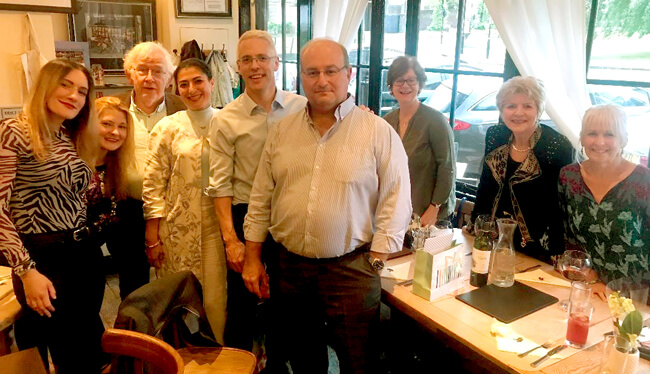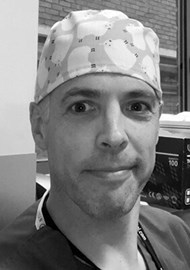In his inimitable way, Nick Gibbins tells us why the voice clinic is the highlight of his week – and his very own field of dreams.
The voice clinic has come a long way in the last 40 years. The first in the UK were set up in the early 1980s and spent years on the periphery of ENT. They were usually solitary affairs with a paucity of patients but, as was once explained to Kevin Costner, ‘if you build it, he will come’, and so demand for a specialist voice opinion slowly increased.
Still, for 20 further years, voice stayed on the edge of the ENT landscape but since the turn of the millennium, laryngology as a specialty has gathered momentum. Laryngology has found links with other specialties; some more obvious from an anatomical point of view, such as respiratory medicine and upper GI surgery, and some less so such as neurology and rheumatology. It is difficult to demonstrate causality, but this might have coincided, and only have been possible, because of the increasing emphasis for the patient to be viewed and treated holistically, looking at the whole person rather than only at the disease. The more the specialty has expanded, led as it has been by our colleagues across the pond or on the continent, the more facets of management the voice clinic has obtained. In 2020, the UK can rightfully say that we have a laryngology service that can rival any other. However, in contrast to our colleagues from abroad, it is in the area of the multidisciplinary voice clinic that the UK can rightly claim to be at the forefront.
If you will forgive the author’s romanticism (maybe it is because we are now back in the ‘20s), I truly believe we are at the start of a golden era of laryngology in the UK – an ever-increasing range of procedures are migrating from theatre to the clinic (in-office), new fields such as neurolaryngology are being championed, and the range of surgical treatments for conditions previously considered near-impossible to treat is increasing at an almost exponential rate. Everywhere you look laryngologists are researching novel ways to treat patients and are sharing their results so that everyone can benefit. However, none of this can happen without an accurate diagnosis. And this is made in the voice clinic.
The voice clinic MDT is unlike, say, a head and neck MDT where the patients have already been seen, investigations secured and what is being discussed are the management options for the patient. The voice clinic is a dynamic MDT in that the discussion is had at the time of seeing and examining the patient. There are multiple pairs of eyes in the clinic room and each looks at the patient with a different training, set of skills and thought process.
The members of the voice MDT are varied but at its core remain an ENT voice specialist surgeon and a speech therapist. On the continent, the phoniatrician often covers both roles and works alone, but in the UK the different training of surgeons and therapists means that the anatomy, physiology and psychology of the patient are viewed in separate but overlapping ways, giving a rounded overview of the patient and their condition.
“In contrast to our colleagues from abroad, it is in the area of the multidisciplinary voice clinic that the UK can rightly claim to be at the forefront”
Other members of the team are varied but in our clinic, we are lucky enough to have a laryngeal osteopath and a vocal rehabilitation coach. Having four people in the clinic room around the patient may seem cumbersome but when taking a history, pertinent questions are put forward: “I see your left shoulder is lower than your right – have you had an injury?”, or “you are studying musical theatre, how much dancing are you doing? What positions are you having to sing in on stage? Do you warm up and down?”

The voice MDT, consisting of surgeons, SLTs, osteopaths, vocal rehab coaches, and Masters students.
As well as these relevant and probing questions, the atmosphere in a room with professionals that respect each other’s views is part of what can help put the nervous patient at ease. It can often be the case, especially in patients with tricky diagnostic conundrums, that the patient will have gone ‘around the houses’ for months if not years. In the case of the dysphonic singer, they may have sought help from a number of speech therapists, singing teachers and finally badgered their GP into sending them to an ENT clinic, only for the clinician in the two-week-wait cancer clinic to reassuringly and correctly tell them they don’t have a malignancy and discharge them. When this now rather jaded patient enters the outpatient department and gets not one, but two, three or even four medical professionals listening, taking their symptoms seriously and discussing their examination findings and management options, it reassures them that they are in the right place. Anecdotally I have had patients become emotional, not because they have obtained a definitive diagnosis or a panacea to cure their ills, but rather because they have been taken seriously, sometimes for the first time. The dynamic voice MDT can be a very powerful tool.
The composition of the MDT varies between clinics and is adapted for the patients being seen. A dysphagia clinic will have the same ENT surgeon, probably the same laryngologist, and an expert speech pathologist but may have the help of a gastroenterologist and/or links to their local and friendly upper GI team. Similarly, a dedicated cancer rehabilitation clinic may still involve the same personnel, but its emphasis would be skewed toward voice and swallow rehabilitation.
“There are multiple pairs of eyes in the clinic room and each looks at the patient with a different training, set of skills and thought process”
It is usually the case in MDTs that patients are seen by the individual clinician, examinations and investigations performed and only once these results are in and all the information is collected, is the patient’s case brought before the MDT. The patient is rarely in the room when the discussion takes place and this is the major and fundamental difference that sets the voice clinic MDT apart from the others. I do not say this to posit its superiority but rather to highlight the dynamic and sometimes fluid nature of the decision-making process.
With the variety of personnel in the clinic it is imperative that a consensus is reached in every case and the patient leaves with a clear understanding of the management plan. Having different viewpoints gives the patient a multifaceted and holistic plan with a timetable. This last point has usually been lacking in the patient’s journey so far, and a scheduled plan helps the patient plan their diary accordingly and give them focus. In some, factors may have escaped the notice of one or more of the MDT and this can be raised at the time by others in the room. It is certainly my experience that in patients where the endoscopy is difficult for whatever reason, most of my concentration goes towards getting a clear and close-up image on the screen. In these situations, subtle factors of the examination often escape my attention but are immediately picked up by others in the room and voiced – feeling comfortable and safe doing so – and this can only be the case when all members work closely together for some time.
It is this last point or all of the above that I would labour – work together, work often, and have fun. The voice MDT is enormously challenging but can be enormously rewarding in kind. It is often the hardest clinic of my week, but is almost always the best.
Declaration of Competing Interests: None declared.




